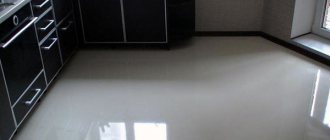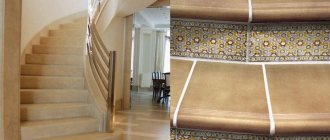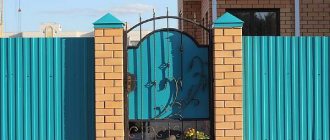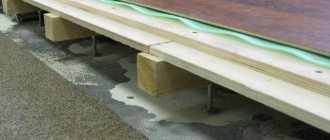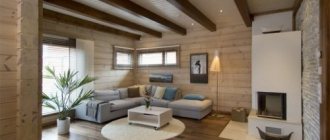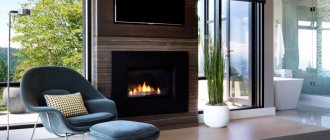When starting to build a house, the question of floors arises first of all, since the strength of the coating and the preservation of heat in the rooms, and therefore the health of the residents, will depend on them. Flooring in a private home can be installed in several ways, but you need to consider each of them in order to evaluate the pros and cons of each option.
Floor installation in a private house
- Wooden flooring has always been considered the most popular and comfortable floor for a home, since wood, unlike concrete, is itself a warm material.
- Concrete coverings are more durable than wood, but require good insulation, so they are often combined with wooden floors.
- Loose or floating floors were not so popular among home owners in the past, but recently many are increasingly turning to this option, as it is easy to install and can be done in literally one day.
Whatever flooring is chosen, it has specific features of its design, depending on the design of the house, the area on which it should be laid, the difficulties and nuances of installation, and even the financial capabilities of the homeowners.
In order for the floor in a private house to be warm and pleasant to walk on, each of its types requires insulation, so it is necessarily included in the general improvement plan.
Pros and cons of concrete floors
In multi-storey new buildings, reinforced concrete floor slabs serve as the basis for the floors.
In private two- and three-story houses this is not such a strict rule. But the popularity of the technology is obvious. Flooring made of reinforced concrete slabs has a number of advantages. First of all, it is durability. Reinforced concrete, often with prestressed reinforcement, provides reliable flooring. Thanks to the air-filled cylindrical voids of the slab, it provides a comfortable level of thermal and sound permeability. With careful installation, the floor and ceiling come out smooth and suitable for final processing.
Such ceilings are installed using a crane. The slabs are laid on load-bearing walls or columns of a reinforced concrete frame. A cement-sand screed is poured over the floors. Ceiling seams are puttied.
The advantage of this type of floors is that they serve as a universal basis for final finishing of any type. The variety is very great:
- from laying linoleum to type-setting parquet on a subfloor lying on joists;
- from painting the ceiling with water-based emulsion to stretch ceilings with designer lamps.
Pure concrete floors are rarely installed in private homes. An exception may be a painted concrete screed in the basement. There are no strict requirements for coating, especially if you do not install waterproofing.
Floor structures
Their choice depends on how the building will be used in the future. For example, for a small summer cottage, a single wooden floor would be a good option. If the room will be used year-round, an insulated option should be provided.
Plank floor
The easiest flooring option to implement, which can be easily done with your own hands. It is suitable for buildings located in warm regions or for those that are fully used only in the summer.
If the house design stipulates that the floor beams are directly installed into the walls, then the distance between them is often too large for laying the boards. To ensure the necessary strength of the floor, lay wooden beams - logs. Read below about how to make wooden floors in a private house.
Single floor
Advice: when installing the floor on support posts, immediately place the beams at the required distance from each other, then logs will not be needed.
Double insulated plank floor
The method will require more effort and expense, but will make it possible to significantly reduce heat loss.
The instructions below will help you do it yourself.
Below we will talk in detail about how to make a concrete floor in a private house.
Flooring in a private home: what you need to know to make the right choice
The desire to equip your home with a durable and super-reliable floor haunts any private developer. In order to find out which floors are better in a private home, let’s briefly look at the characteristics of the most used structures. These floors can be wooden, concrete or formed on a screed base.
Wooden floors
Wood is known to retain heat well and is environmentally friendly. However, wood is not resistant to moisture, so there will be a need to use waterproofing materials.
Concrete floors
Concrete floors in a private home are considered to be the most durable. But there is a drawback here too. Such a monolithic floor must be supplemented with careful insulation, since concrete itself is a very “cold” material.
Dry floor screed
A floor with a dry screed is relatively young. Dry floor screed has excellent thermal insulation; the main thing is to lay and compact all layers perfectly so that there are no distortions.
Wear-resistant inserts in floor design
Floors with wear-resistant inserts are a fashion trend. The main passage part is laid out with tiles, marble or porcelain stoneware, the rest - with parquet or laminate.
These materials are considered wear-resistant because they are resistant to moisture, chemicals, mechanical damage, and temperature fluctuations.
They are practical and have been used for several years. The design can be monochromatic or contrasting.
Double wooden floor
If you are wondering how to make a wooden floor, then you are in luck, because we will look at this option in detail, since it is used most often.
If you want to do everything as efficiently and correctly as possible, then try to follow all the points of the instructions below as accurately as possible. So let's get started:
The first step is to lay the beams. They are placed on top of the installed pillars on the support beams. The beginning of any flooring construction begins with this.
Already on these installed parts you need to lay a subfloor made of boards, which should be fitted as tightly as possible to each other.
Absolutely any boards are suitable for this, as long as they have a thickness of two to four centimeters. It doesn’t matter what quality they are, but it is advisable to use coniferous wood material.
Pre-prepared boards are fastened with nails; they should be driven in at an angle of forty-five degrees. The distance from the edge should be at least twenty centimeters.
After the final installation of the subfloor, you need to begin laying the thermal insulation layer. To do this, use foam sheets or mineral wool mats.
On top of the laid layer you need to lay out a six-centimeter layer of expanded clay, and on top of it you need to apply a polymer film. She will be involved in vapor isolation.
Once you have completed all these processes, you can begin laying the finished floor. For this it is better to use high quality boards; they will be attached with nails.
Subfloor options
Much has been said about the rough coating above, and therefore I would like to dwell on it in more detail. It is the first layer that precedes the laying of the decorative (main) coating.
Construction of a subfloor for insulation with expanded clay
There are various subfloor options. They differ in the chosen method of insulation.
Which option should I use? It depends on the specific conditions, but everything can be easily done with your own hands. The main thing is to take your time and follow the stages of waterproofing, vapor barrier and insulation.
Installing a floor in a private home requires two main things: quality materials and compliance with all rules. Then the floors will be warm, and living in a private house will be comfortable.
Most Russian houses were built during the Soviet era and now need major repairs. You need to start updating old structural elements in a private house by repairing the floor, since it is through it that most of the heat escapes in winter. It is best to start restoring the floor in a private house from scratch. Therefore, first of all, you should dismantle the old structure and buy new materials that will make it possible to create a floor with good thermal insulation.
The old elements in the house should be updated by repairing the floor, because in the cold season it is from it that heat leaves.
How to make the floor yourself in a private house reliable and warm? There are many options. The choice of technology, first of all, depends on how much money people are willing to invest in repairs. Depending on the available budget for repairs, you can determine the materials and method of reconstructing the floor in a private house.
It is preferable to completely redo the floor in a private house, but this will require more money. If a minimum budget is allocated for repairs, you can limit yourself to updating the old structure.
Types of floors for private houses, their advantages and disadvantages
Wood flooring and concrete are most often used as flooring. Currently, self-leveling floors are becoming popular and are often used to furnish one or more rooms. Which material is better to choose for your home? In order to make the right decision, it is necessary to consider the advantages and disadvantages of each type of coating.
Wooden covering
Wood attracts consumers with its environmental friendliness. Pros of wooden floors:
- when choosing high-quality material, there is no need for flooring;
- retain heat well;
- do not create a large load on the supporting structures of the building;
- a damaged board can be easily replaced with a new one;
- you can change the design, since wood lends itself well to staining.
When arranging wooden flooring, you need to take into account the construction features. If a private house does not have a basement floor, then it is better to build a double floor to place a layer of insulation between the rough and finishing coating. Wooden boards of lower quality are used as a rough layer. Wood floors have a number of disadvantages:
- for installation it is necessary to provide additional structures - logs, which makes installation labor-intensive;
- it is necessary to treat materials with fire retardants and special substances to reduce fire hazard and increase service life;
- with increased humidity in the room, the wood begins to rot;
- wood is susceptible to rodents and insects;
- When it dries out, cracks form and the boards crack.
Concrete floor
The popularity of concrete floors is due to their durability. The benefits also include:
- quick and easy installation;
- cheaper than wooden ones;
- moisture resistance;
- high strength;
- not interesting to rodents and insects;
- fire resistance.
However, concrete creates additional load on the foundation and supporting structures of a private house, so you need to make calculations first. For wooden cottages and the second floor, a concrete floor is not the best solution. Other disadvantages:
- if the installation technology is violated, the concrete may crack;
- filling requires the use of rules and special beacons to control the level;
- after pouring, you cannot immediately begin using the premises (it takes about a month for the surface to completely dry);
- In living rooms, concrete floors should not be left without a floor covering, as they are cold;
- Without a fine finish, the surface looks unattractive.
Self-leveling floor
Self-leveling floors attract consumers with their ability to give the room an unusual and attractive look. They are made from special mixtures that can self-level after application to the surface. Advantages:
- a smooth and beautiful floor is created;
- the materials used save the owner from the need to use another decorative coating for the floors;
- There are numerous design options;
- you can move on the floor within 12 hours after applying the mixture;
- coatings retain heat well.
The main disadvantage is the high cost. The disadvantages of the coating also include:
- the need for preliminary preparation of the concrete screed;
- special equipment is required for application;
- If the technology is violated, bubbles form on the surface.
Material requirements
There are only two basic requirements for flooring materials:
- Environmental friendliness. If you live in the house permanently, then you can choose respectable coating options such as parquet, tongue-and-groove boards, and porcelain stoneware. If a private house is used for living only in the warm season, then you need to pay attention to how the coating tolerates changes in temperature and humidity. In this case, linoleum and tiles are optimal.
- Strength and durability. If the house is designed to last for several generations, then the service life of the material is of primary importance. Replacing flooring in a spacious private home requires financial, time and labor costs.
Less significant, but also important requirements include the design and comfort of coatings.
Choosing a floor base and a method for constructing a good floor
Arranging a floor in a country cottage, in a country house or in your own home is a serious and responsible task that many try to solve on their own. However, without studying the features of the technology, it is problematic to give a clear answer on how to make a floor in a private house. It is important to think through not only design issues, but also decide on the method of installing the floor base and the materials used.
A serious and responsible task: arranging the floor in a country house
The most common in the private sector are the following self-installed flooring options:
- wood. The main advantages of wood flooring are environmental friendliness and increased thermal insulation characteristics. At the same time, wooden boards are characterized by increased hygroscopicity and require effective waterproofing protection. The wooden floor is laid on support beams located above the ground surface, on wooden beams resting on brick pedestals, as well as on planks laid on a concrete or cement screed. Building a wooden floor is not difficult. The plank base is durable, maintainable and attracts attention with its original texture. The correct selection of material for a plank base determines the performance characteristics. It is important to use dried wood, the moisture concentration of which does not exceed 12-14%. The use of boards with defects in the form of cracks, falling knots and chips is not allowed. The materials used are coniferous trees and hardwood. Impregnation of boards with antiseptic compounds ensures the durability of the structure;
Environmental friendliness and increased thermal insulation characteristics are the main advantages of wood flooring
- concrete. It surpasses all types of floor bases in terms of strength characteristics and service life. When making a concrete screed of increased height, the concrete mass is additionally reinforced with a reinforcement grid. It prevents cracking of the monolith. However, the concrete base has a serious drawback - increased thermal conductivity. To ensure a comfortable temperature of the concrete floor and reduce heat loss, be sure to lay insulation in the form of granulated expanded clay, polystyrene foam or extruded polystyrene foam. A waterproofing material is placed on top of the insulating layer, and then the concrete mixture is poured. It is important to use a fresh concrete solution made from Portland cement grade M400 and higher. To improve the appearance and increase thermal insulation, a concrete base is combined with a wooden one;
- floor base in the form of a dry screed. This type of floor has gained popularity relatively recently and is a progressive solution in the construction industry. A dry screed is also called a loose floor or a floating floor structure. This type of base attracts with its ease of formation and accelerated pace of work. Dry screed is performed on a planned base, which is waterproofed and then logs are laid. Fine expanded clay, slag or sifted sand are poured into the space between the joists. Then you need to pull off the bulk composition and distribute it evenly over the entire area. At the final stage of dry screed construction, OSB floor boards are laid or sheet plywood is installed. Floor screed with expanded clay is durable and prevents heat loss.
When choosing installation methods and material for the future floor, you should study the design features of the floor base, as well as analyze its advantages and weaknesses.
All types of flooring subfloors are superior to concrete flooring
Tile
Budget floor tiles can easily be considered one of the cheapest types of coatings.
The main advantage of this material is its durability and wear resistance. A properly finished floor will last for many years.
It is worth noting the external attractiveness of the tiles - such interiors look solid and solid.
Ceramic tiles are not afraid of moisture, grease and do not absorb odors.
We make floors in a private house using wood
Wooden floors are often preferred due to their attractive appearance and environmental friendliness of the material. To ensure the reliability of the plank floor, you should not only decide on the wood, but also choose a design option. Wood floors are constructed using various methods. In this case, logs made of wooden beams are an integral element of the structure.
The logs are laid on the following bases:
- beams fixed to the walls of the building;
- columnar supports made of bricks or blocks;
- concrete screed reinforced with reinforcement.
Depending on the customer’s wishes, builders construct a single-layer version of a wooden floor or form a two-layer wood base laid over a subfloor made of unedged boards or concrete. Let us dwell in detail on the technological aspects of the construction of various options for wooden floors.
Due to their attractive appearance, wooden floors are preferred
We lay floors with our own hands in a private house on the ground on beams
Beginner developers are interested in how to make floors in a house from scratch using wood. They mean the situation when the walls of the building have already been erected, the roof has been installed, and the floor base is ordinary soil.
So, the construction of a plank floor on a beam base located above the ground is carried out according to the following algorithm:
- A surface layer of soil 8-10 cm thick is removed.
- The stones are removed and the surface is ensured to be level.
- A sand-crushed stone mixture is poured onto the soil surface in a layer of 10-15 cm.
- The bedding is leveled, watered and compacted.
- A layer of waterproofing made of sheet roofing material or polyethylene is laid.
- Logs are laid ensuring an interval of 0.6-0.8 m between wooden beams.
- The joists are attached to the foundation walls using steel plates.
It is important to ensure that the joists are horizontal and that they are correctly adjusted to their level during installation. For this, wooden supports are used. A floor made of planed boards is installed on the prepared base.
Wooden floors are secured to joists
The following types of installation of the plank base are possible:
- with additional thermal insulation of the floor. The technology for arranging a wooden floor provides for the possibility of laying heat-insulating material in the space between the joists. Mineral wool, expanded clay granules or expanded polystyrene sheets are used as insulation. After insulation, finished floor boards are attached to the joists;
- without insulation of the wooden covering. With this method of installing the floor, no insulation is used. Boards are attached to the upper plane of the support beams, performing the functions of a subfloor. A second layer of finishing boards is laid on the rough base or a finishing coating in the form of OSB boards or moisture-resistant plywood is installed.
When carrying out work, gaps of 20-25 mm should be provided between the foundation base and the logs to compensate for temperature expansion.
How to make a warm wood floor on support pillars
Having decided to make a floor in a private house themselves, many people prefer a wooden structure formed on support posts. This installation method is used when it is necessary to raise the floor surface, eliminate distortions in the floor base, and also when the distance between the walls is increased. Indeed, in the absence of additional supports, there is a high probability of violation of the integrity of the joists under the influence of loads.
If it is necessary to raise the floor surface, use support posts
When constructing a wooden floor on additional concrete supports, follow the given procedure:
- Remove the fertile soil layer and level the surface.
- Determine the coordinates of the location of the support pillars.
- Extract the soil according to the markings and prepare pits for the support pipes.
- Fill the bottom of the pits with a mixture of sand and crushed stone.
- Level the bedding and compact it thoroughly.
- Assemble formwork of the required height around the perimeter of the pits.
- Place roofing felt inside the formwork for waterproofing.
- Assemble the reinforcement grid and place it in the formwork.
- Pour the concrete solution and compact it.
The concrete hardening process lasts 4 weeks. After the concrete has gained operational strength, dismantle the formwork and lay supports of the required height from bricks or blocks on the concrete surface. Lay roofing material on the surface of the formed pedestals, designed to protect wooden beams from ground moisture.
Floor on support pillars
When performing work, the following dimensions must be maintained:
- the interval between supports is 1-1.2 m;
- the distance from the foundation to the outer pedestals is 0.4 m;
- location of the base of the pits from the zero mark at the level of 0.4-0.5 m;
- thickness of crushed stone-sand cushion – 0.1-0.15 m;
- cross-section of columnar supports, amounting to 0.4 * 0.4 m or 0.5 * 0.5 m.
It is important to control the location of the upper plane of the supports at the same level. This will prevent distortions and create a flat floor. Remember that the technology allows the lags to be made in composites with the beams connected on the central support with an overlap of 0.15-0.2 m.
Tips for laying floorboards or plywood on a concrete base
Often a concrete or cement screed is used as a floor base. Massive interior items can be installed on a wooden floor formed on a base of concrete or cement. A plank, plywood or tiled floor, built on joists attached to concrete, reliably insulates the floor of the room and has an increased load capacity.
Concrete or cement screed is often used as a floor base
Follow the following procedure for constructing a wooden floor using a screed:
- Level the concrete base and seal the cracks.
- Fill with self-leveling mixture if necessary.
- After the mixture has hardened, lay down the waterproofing material.
- Mark the surface of the base for laying the lag.
- Make holes in the concrete and attach pins to secure the planks.
- Drill holes in the beams corresponding to the coordinates of the studs.
- Place the strips on the studs and check that they are level.
- Remove the parts of the studs that protrude beyond the top plane of the beams.
- Fill the space between the joists with sheet or granular insulation.
- Install a finishing covering of boards or plywood to the joists.
Do not forget to provide gaps to compensate for temperature deformations between the end plane of the joist and the walls of the room.
Dry floor screed under plywood sheets
The technology for forming floors in rooms using dry screed is quite simple. The essence of the method is to use crumbly material as a floor base, evenly distributed over the area of the room.
Various types of bulk materials are used:
- dry screed “Knauf”;
- small expanded clay granules;
- sand concrete mixture on a quartz or silica base.
A fairly simple technology for forming floors using the dry screed method
A distinctive feature of the materials is the absence of shrinkage after leveling. This flooring lasts for a long time and retains heat well in the room.
The procedure for constructing a floor using the dry screed method:
- Lay a layer of waterproofing on the prepared surface.
- Secure the strips that serve as guides.
- Fill the space between the beacons with the dry mixture and level it.
- Compact the loose base material.
- Attach plywood boards to the guides using self-tapping screws.
- Seal joints between sheets of plywood.
- Place the finishing coat on the prepared base.
When performing work, check that the slabs are laid horizontally and move from the front door into the interior of the room.
Installation of wooden floors
When building a private house, many people prefer to make the floor out of wood. This desire to have high-quality wooden flooring under your feet is explained by the desire to use environmentally friendly materials, which include wood. In addition to being highly environmentally friendly, such a floor has a number of other advantages.
Wooden floors are easy to install and easy to repair during use. Due to the low thermal conductivity of the material, such a floor will retain heat inside the house without letting it out. Plank flooring made from high-quality wood has a long service life and an attractive “natural” appearance.
To make a floor in a private house, you need to choose the right wood. The choice of source materials should be based on the design features of the structure itself. The installation of a floor in a country house must necessarily include the presence of a subfloor that acts as an air gap. If such a layer is missing, the wooden floor will quickly become unusable due to exposure to moisture. In addition, for a good floor, it is important to have all the layers of the structure, including joists, rough flooring, hydro- and thermal insulation, and a finishing coating.
The floor in a private house is subject to significant mechanical loads, so for its construction it is necessary to choose wood with good technological characteristics. The boards must be well dried, the recommended moisture content is no more than 12%. Any chips or cracks on the surface of the material are not acceptable. Experts recommend giving preference to coniferous wood; pine, larch, fir, and cedar are suitable. To increase the service life of the future floor, all boards must be treated with an antiseptic and fire retardant.
Installation of a wooden floor begins with determining the locations for the support posts and their installation. The fertile layer of soil around the entire perimeter of the house is removed and removed, gravel is poured in its place, and sand is poured on top of it. Layers of gravel and sand must be compacted well. Waterproofing material is laid on the ends of the support pillars; most often, ordinary roofing felt is used for these purposes.
Backfilling with gravel.
Next, we make beams that need to be secured to the posts with metal corners. It is better to make floors in a private house with double insulation. Experts suggest first laying plywood sheets on the sides of the beams, and then placing mineral wool or other insulating material on them.
When the insulation layer is ready, you can begin laying the rough covering. The boards of this layer should fit well to each other; ordinary screws can be used to attach them to the beams. It is better to leave some distance between the flooring and the walls of the house: a gap of 1.5 cm can be considered the norm for this part of the floor. These gaps provide ventilation to the entire floor structure and protect the walls from expansion of the floor boards as they subsequently dry out.
A layer of vapor barrier made of polyethylene film with a thickness of 200 microns is laid on top of the subfloor. The joints of individual pieces of film must be taped, and the edges must be folded onto the walls to a height of about 20 cm - the height of the final coating. When the film is laid and secured, you can proceed to assembling the finished floor.
The finished floor is assembled from solid wood boards or plywood sheets. Plywood sheets are easier to attach, but in the end they don’t look very attractive. Therefore, if you want to leave wooden floors in your house, then it is best to immediately assemble the final covering from a tongue-and-groove board, and if you plan to cover it with decorative material, just secure plywood sheets. After assembling the finished floor, plank floors must be coated with varnish, which will not only protect the material from external influences of a mechanical and chemical nature, but will also emphasize the decorative qualities of natural wood.
Linoleum
The range of prices for linoleum is quite large, so we can only talk about savings if we use the cheapest types of this material.
The main advantage of the coating is its versatility - linoleum can be used in any type of room.
The material is also extremely easy to care for, since any dirt can be easily removed with a wet cloth.
Even budget linoleum is quite wear-resistant. It is very difficult to scratch, tear, or pierce. Also, under the influence of external factors, it does not change its technical characteristics.
Laminate, tile and other types of flooring
Flooring is the exterior finish of a floor. They are needed to give the room an attractive look and additional insulation of the premises. Applying a topcoat to a wooden surface makes it more durable. As you can see in the photo, there are many options for flooring, available in different colors and textures. The table provides a brief description of the most popular of them.
| Name | Description | pros | Minuses |
| Laminate | Coating that imitates wooden boards. Consists of several layers: paper impregnated with resin or paraffin, HDF, decorative and protective film. Thickness – from 6 to 12 mm. |
|
|
| Linoleum | Flexible fabric produced in the form of rolls. Made from natural materials or polymers. |
|
|
| Ceramic tile | Plates based on baked clay. |
|
|
| Cork | It is made from cork tree bark in the form of slabs. |
|
|
| Wooden parquet | It has the form of plates that fit into the canvas. |
|
|
| Carpet covering | Rolled material with a fleecy surface. |
|
|
| Stone | Stone slabs of various shapes and sizes. |
|
|
Zoning in floor design
Zoning a room using floors is a common practice when creating an interior. It solves several problems.
Firstly, it looks beautiful and unusual.
Secondly, different floors divide the room into several zones. The functionality of the room becomes more practical.
Sometimes zoning is achieved by using a podium in the working part of the room made of a different material.
Flooring in a private home: what you need to know to make the right choice
The desire to equip your home with a durable and super-reliable floor haunts any private developer. In order to find out which floors are better in a private home, let’s briefly look at the characteristics of the most used structures. These floors can be wooden, concrete or formed on a screed base.
Wooden floors
Wood is known to retain heat well and is environmentally friendly. However, wood is not resistant to moisture, so there will be a need to use waterproofing materials.
Concrete floors
Concrete floors in a private home are considered to be the most durable. But there is a drawback here too. Such a monolithic floor must be supplemented with careful insulation, since concrete itself is a very “cold” material.
Dry floor screed
A floor with a dry screed is relatively young. Dry floor screed has excellent thermal insulation; the main thing is to lay and compact all layers perfectly so that there are no distortions.
Choosing flooring for different rooms of the house
What flooring is best to use for different types of rooms in the house: kitchen, living room, bathroom, bedroom and children's room?
It all depends on the design idea. In the living area, where upholstered furniture is located, it is most often solid wood or parquet boards. In wet areas (kitchen and bathroom) these are porcelain stoneware and tiles.
What kind of covering is best to lay in active areas of the house (for example, in the nursery, gym)?
Very often, cork is used to cover children's rooms. But they forget that the cork wears out not only the fabric of the child’s clothes, but also the knees. Therefore, any fall on a traffic jam is quite traumatic. But she is practically indestructible.
Cork floor in the children's room
Concrete floors in a private house
Concrete floors in a private house have some complexity in their construction, so it is better to carry out all these steps with a person who has at least some experience working with this construction raw material. One of the disadvantages of such floors is labor-intensive dismantling. But such work is carried out extremely rarely, so they do not deserve special attention. Before you make a concrete floor in a private house, you need to collect important tools, such as: a concrete mixer, a shovel, buckets, a construction wheelbarrow, a trowel, a level, a rule and a wire brush. So, what does the process of concreting floors in a private house look like?
- First you need to level and compact the soil, removing any stones.
- We fill the entire area with sand mass, moisten it, press it and let it dry.
- Then we lay oilcloth (membrane) and insulation (for example, expanded polystyrene). Concrete floors in a private house may have a rough screed, which is formed on sand, in front of hydro- and heat-insulating pads.
- The reinforcing mesh is laid and filled with a well-mixed concrete solution, which will dry for at least a month. An important point: before pouring, it is necessary to form beacons from a metal profile, as shown in the photo.
- The flooded floor should be covered with plastic film to avoid rapid drying.
Kitchen floor tiles - practical advice on choosing
Cork
Among natural materials, the most budget option is cork. This is wood bark that has undergone special treatment. Floors covered with it look very natural. Cork is softer than linoleum, so walking on such a surface barefoot is extremely pleasant.
The material has a porous structure, due to which a room with such a floor has good heat and sound insulation.
The big advantage of cork is its low static properties - dust practically does not stick to the surface.
The material does not absorb water or any other liquid, so the likelihood of stains is reduced to zero.
By choosing one of the presented flooring options, you can create a cozy interior without harming your wallet. When making a decision, you should consider the type of room in which the material will be used.
Source
If we compare living in an apartment building and a private house, the latter wins in many respects. However, not many people decide to move. Why? Not many people are ready to take care of their homes on their own, as they are accustomed to public utilities doing this.
Moreover, if you have to do major repairs or carry out any additional construction. However, there are enthusiasts, and there are many of them, for whom life in nature cannot be compared with any city amenities. They independently undertake the reconstruction of their home, sometimes without even having sufficient knowledge, for example, about how best to install a floor in a private house.
This, of course, is commendable, but on the other hand, it is better to prepare in advance for a difficult task and treat it responsibly than to redo it later or not finish it as needed. Below in the article we will talk about how to make floors in a private house, where you will learn about its basic structures, waterproofing and insulation.
Requirements for floors in different types of rooms
When choosing the material and type of coating, it is necessary to take into account the purpose of the rooms. Requirements for floors in different rooms:
- Hallway. A large amount of dirt accumulates here. Floors are subject to high mechanical stress. You need to choose durable, moisture-resistant coatings that are easy to care for.
- Kitchen. The room is exposed to hot fumes, and dirt often gets on the kitchen floor. Coatings must be moisture resistant and easy to clean.
- Living rooms. For them, it is necessary to select environmentally friendly coatings that retain heat.
- Bath and toilet. These rooms have high humidity. Floors in bathrooms and toilets must be moisture-resistant and not deteriorate from exposure to household chemicals.
Warm floor
They solve the heating problem and are mounted under any type of coating.
Cable floor
A heating cable is used. As electric current passes through it, heat is generated. It is usually installed under tiles.
Heating mat
This is a thin cable fixed in a synthetic mesh. A heat insulator with a reflective surface is placed under the covering (laminate, tiles, etc.), and the roll is secured with glue or tape.
Film or infrared floor
It is a film that emits infrared radiation. It is ultra-thin, the radiation does not harm humans. The temperature is controlled by a thermostat.
How to make a floor using joists
Making floors in an apartment or house with your own hands using joists is much easier.
Making floors in an apartment or house with your own hands using joists is even easier, but only when the height of the ceilings allows. Many experts recommend this option, emphasizing the optimality for several reasons:
- This is a dry method that does not require screed;
- The increased speed of the entire procedure allows you to move on to finishing work without much time investment.
If you do everything correctly, your new flat floor will be ready in just a matter of days. But first, they putty, fill cracks, chips, etc. Then waterproofing and installation of logs. For this purpose, a beam with a height of up to 70 mm is used, set in a horizontal plane. The process will be facilitated by placing the two outer lags with stretched transverse threads - it is easier to align the intermediate elements using them without losing their height and evenness.
After preparing the sheathing, lay a layer of insulation and waterproofing between the joists, attached directly to the bars, and any material of your choice is placed on top of the structure. For example, if you want a wooden floor in your apartment, take boards, but for heated floors you will need to make a solid foundation:
How to properly screed a floor in an apartment?
- Plywood sheets;
- OSB;
- Boards.
The sheathing is adjusted for sheets and slabs so that each element covers three bars: one in the middle, two at the edge. The support must be strong, but the tile material should be laid out, slightly shifting it. This improves the distribution of the load; it will fall evenly over the entire area of the base. You will have to decide what and how much material to take yourself, calculating the area to be covered. It is convenient to install floors on joists in a new apartment, starting a renovation from scratch and in a room where the floors are pretty worn out. The option is extremely economical, especially when using expanded clay as a heat insulator, while the materials are lightweight, which means there will be no extra weight on the floors.
But there are a number of points that must be fulfilled:
- The tree is coated with an antiseptic;
- The top side of the plywood is coated with hot drying oil so that the base always remains dry;
- Fastening with self-tapping screws along the joists will ensure strength;
- The joints are sealed with dry construction tape and puttied.
Important! If you want to make a solid floor, you can lay plywood in 2 layers, but in this case, self-tapping screws and glue are used for the top sheets. Now the coating is ready for final finishing and you can lay parquet, laminate, carpet or tiles. To make the process even clearer, watch the video.
Illuminated floor
Illuminated floors are a fashion trend. The advantage is not only that the room looks unusual. Backlighting becomes an integral part of general lighting.
It must have a high degree of protection from water, mechanical stress, and heat. It is better for the glow to be soft and muted.
Suitable lighting devices include spotlights, LED strips, neon cords, and light modules.
Illuminated floors are ideal for hallways, bathrooms, kitchens, and bedrooms.
Self-leveling floor coverings
Floors that contain a polymer are traditionally called poured floors. There are options when the polymer is mixed with traditional cement and sand. And there are entirely polymer materials.
Mixed types of poured floors include the so-called self-leveling ones. In addition to cement and sand, their composition includes a small amount of polymer plasticizer, which increases the fluidity of the solution. This allows the coating to form a perfectly horizontal surface without leveling, which is very convenient. Pour the self-leveling mixture in a more or less even layer over the entire room - and relax. The coating will spread on its own and form a smooth surface without blemishes. Such floors are becoming increasingly popular.
There are several types of polymer bulk mixtures:
- highly filled floor, which is especially durable;
- epoxy coating - resistant to mechanical and chemical influences;
- polyurethane flooring is very elastic, but does not tolerate contact with chemicals;
- methyl methacrylate from acrylic resins - hardens in just a couple of hours.
Polymer self-leveling floors are usually made in industrial or public buildings. They are very technologically advanced and allow you to fill huge rooms with an even, mirror-like layer without seams. It is very beautiful, especially if there is a large enough open space.
In a private city or country house, large open spaces are rare, and self-leveling floors do not look so impressive. A smooth, mirror-like surface subjectively looks slippery and cold. Therefore, self-leveling floors are used relatively rarely in private housing construction.
Video: a visual example of installing a subfloor
Wooden floor on the ground
A wooden floor is also installed on the ground. For this, there is a scheme, based on which you can draw up a work plan.
Approximate diagram of laying a wooden floor on the ground
- The soil in the underground must be compacted well, and a cushion of sand, gravel or medium-fraction crushed stone, 20 to 40 centimeters thick, placed on top of it, and then compacted again.
- Rigid waterproofing, for example, roofing felt, is laid on the compacted cushion. If desired, you can lay reinforcement mesh under it for greater strength. Waterproofing should extend to the walls at least 10 centimeters.
- For waterproofing, bricks or concrete blocks are placed on the mortar, which will subsequently become a support for the beams. The supports are placed in such a way that the beams are at a distance of 60 centimeters from each other (standard insulation width).
- The first layer of insulation is laid around the bricks - this can be 50÷100 mm polystyrene foam or mineral wool.
- Wooden beams are installed on bricks, or better yet, on concrete blocks, leveled, and secured with a corner.
- Between the laid beams, for greater insulation, you can additionally lay mineral wool slabs.
- A vapor barrier film is secured on top of the insulation.
- Then lay the floorboard, which is secured with nails carefully driven into its side.
- The board is laid at a distance of one to one and a half centimeters from the wall to ensure ventilation.
Wooden floor on concrete screed
When installing a floor on a concrete screed or slab, the logs can be laid directly on the concrete or, if you need to raise the floors to a small height of 10-20 centimeters, on threaded studs.
When laying floors on concrete, you cannot skimp on joists - they must be quite massive, then the floors will be reliable and non-creaky.
It should immediately be noted that with such a floor arrangement, it must be made of two layers, i.e. with the subfloor described above, otherwise it will be very cold.
- First, a preliminary marking of the location of the joists is made on the concrete surface. They should be installed at a distance of 60 centimeters, taking into account future insulation. Marking is done by marking a line with color.
- Next, marks are made on the broken lines at a distance of 30-40 centimeters.
- At these points, holes are drilled into which studs are installed with clamps located at approximately the same height from the floor - they will hold the beams.
- Holes are drilled in the beams themselves at a measured distance corresponding to the location of the studs mounted into the surface of the concrete, after which the beam is placed on the studs.
- Then, using a level, tighten the clamps in one direction or the other, bringing all the beams to an ideal horizontal level, controlling it with a level.
- The nuts are tightened on top of the studs, driving them into the prepared recess, and the excess part of the studs is cut off with a grinder.
- The next steps are the installation of the subfloor, insulation and laying of the finished floor.
Floor design
The floor in a private wooden house can have a different design. Constructive solutions are chosen based on the operating characteristics of the future building. For small private houses, it is enough to equip a single plank floor. In a permanent wooden house it is necessary to make a double insulated base.
Single floor
This design is the simplest. You can make it very quickly, but keep in mind that it is only suitable for summer houses. In this case, the floorboards are laid on joists or beams.
The logs are laid in increments of about 50 cm from each other. The thicker the board, the greater the distance between the lags can be. They must be leveled so that the floor is level. The joists are attached to the beams with nails, then the floorboards are nailed to them. The single floor is ready.
Double floor
Thermal insulation can be made from materials available in hardware stores, or from sawdust, expanded clay or straw. You can lay the finished floor after thermal insulation is completed, using a tongue-and-groove floorboard.
Concrete floor
The concrete floor in a wooden private house is installed in several stages. First, level markings are made to determine the height of the future coating. In accordance with the markings, a thin cord or rope is pulled, serving as a kind of guide.
After the screed has set, the slats are removed, and the voids left in their place are filled with mortar, leveling the seams. The surface should be covered with plastic wrap and left to dry for 3-4 weeks. At this time, it is necessary to wet the surface several times to prevent it from cracking and to allow the concrete to gain maximum strength.
Materials
If you are choosing what to make a floor from in a private home, wood is most often used. This is not so much a long-standing tradition as a practical understanding of the merits of the material.
It has a number of serious advantages over its competitors:
- low thermal conductivity;
- environmental friendliness;
- simple installation;
- maintainability;
- durability.
If you have not decided which floors to make in a private home, but are considering the option of wood, you should choose it correctly.
There are two main factors influencing the source material, which must be strong, warm and durable:
- Tree species
. The best option for floorboards is ash or oak wood. Such floors are considered the most durable, but not everyone can afford their price. Spruce, pine, fir, larch and cedar have also proven themselves well. - The beams and boards must be dried
, with a moisture content of up to 12%. Otherwise, they may become deformed during operation.
Wood is a competitor today, despite its advantages. Very often the choice is determined by the strength of the material and its durability.
When choosing this method, you should ensure the quality of the concrete and not violate the work technology. You can also use the services of professionals working under the slogan - we make floors in a private home from any material.
Base structure
Floor installation in the house
As a rule, wood is used for flooring in private homes. This material is optimal in its practical characteristics:
- Durability of service.
- Environmentally friendly.
- Easy to repair.
- Low thermal conductivity.
- Easy installation.
When you decide to install a wooden floor in a private home, you need to choose the right material. You need to choose wood according to a number of criteria:
- Wood species. The best choice is oak or ash, but these materials are expensive. A cheaper option that is well suited for residential buildings is softwood.
- The wood must be well dried. This applies to both timber and floorboards. Humidity above 12% will cause the floor to deform during use.
- The wood must be of high quality - without cracks, chips or other deformations.
- All wooden floor elements must be treated with antiseptics and fire retardants.
The floor in a wooden private house does not have to be made of wood. Concrete can also be used for this purpose. This material is durable and high quality. If the installation technology is followed, it will last for many years.
Conclusion
Making floors in a private house yourself is not so difficult, the main thing is to follow the stages of work. In the video presented in this article you will find additional information on this topic.
Construction of a private house, as a rule, is associated with many problems and considerable costs. However, there is always the opportunity to save money by doing some of the work yourself. The most important stage of construction is the installation of floors. Let's look at how to make a floor with your own hands in a private house.
Self-leveling concrete floor
Some may think that the concrete surface looks unfinished, however, with skillful design, a unique effect can be achieved. A concrete floor will look great with stained glass windows and paintings, which can be done in a style that is ideal for the overall interior of the room.
It is also worth considering that this coating has many varieties. Therefore, we can say with confidence that every buyer will be able to find an option that will completely satisfy him.
The undoubted advantages of a concrete floor are its ease of use, because it does not require any additional care at all, and the fact that it can be used by people allergic to dust, which quite often accumulates in carpets.
Each room has its own floor
It often happens that in one room you have to lay one type of covering in another. A common example: tiles in the kitchen and bathroom, and starting from the corridor and continuing with other rooms, another covering is laid. This solution can be said to be classic. Waterproof coating in wet rooms, and warm and cozy in residential areas. But there are other combination options. For example, in the kitchen, only the cooking area should be tiled. The dining area can be covered with laminate or other covering. This technique is especially good when the kitchen is combined with the living room.
On the other hand, in the same studio apartment, zoning can be done using different materials. For example, the sleeping area in the main room is lined with carpet or carpet tiles, and the rest of the space is lined with laminate.
Thermal insulation
Where and what kind of insulation to use in a private home
If you plan to live in a private wooden house all year round, you must take care of floor insulation. You can do this in three ways:
- Make an insulated screed.
- Make a double wooden floor with thermal insulation.
- Use modern heating systems such as “warm floors”.
We will not consider underfloor heating systems in this article. You can find many instructions and videos on this topic on the Internet.
Thermal insulation in the screed
The easiest and cheapest way to make the floor warm is to install insulation in the screed. This method allows you to solve the biggest problem of concrete floors - the extreme cold from them.
The technology of insulation in a screed is otherwise called a “floating floor”. This is a multi-layer structure, in the lower part of which a heat-insulating material is laid, and in the upper part a reinforced screed is poured.
When performing such work, a hydraulic barrier made of polyethylene film is first laid, extending onto the walls above the level of the screed. Next, heat-insulating materials, for example, foam, are placed, and concrete is poured onto them. In this case, it is necessary to take care of expansion joints that will not allow the screed to deform under temperature loads. Reinforcement is performed with metal mesh. It is impossible to do without it, since a floating floor without additional reinforcement begins to crack very quickly. The thickness of the screed with this technology should be at least 50 mm.
Thermal insulation of wooden floors
Insulation of a wooden floor has “two sides of the coin”. On the one hand, thermal insulation reduces heat loss, but on the other, it deprives the floor of normal ventilation.
Insulation materials are laid at the stage of arranging the floor in a wooden house. It is best to make thermal insulation using mineral wool. Foam plastic is not suitable for wooden floors, as it has low vapor permeability. There must be a space between the layer of insulating materials and the floor to ensure normal ventilation of the underground.
Floor repair: sequence of actions
You can make a floor from scratch in a private house with your own hands. First you need to remove the old structure, which usually in an old private house is made in the form of a system of logs and wooden covering. If you plan to create a floor covering made of ceramic tiles, you need to make a screed. Tiles cannot be laid on a wooden base. For other types of flooring, for example, linoleum or laminate, you can restore the joist system and insulate the structure.
A new floor in a private house with a screed is created in the following sequence:
Concrete base can be used for any type of flooring.
A multi-layer cushion of crushed stone and sand serves as a shock absorber in case of subsidence and heaving of the soil.
Scheme of pouring a heated floor with concrete.
In addition, it is a container for all communications that exist in a private home. Pipes and wires are insulated in special boxes and hidden under a layer of sand and crushed stone. The bulk pillow is created as follows:
Concrete flooring is more reliable and durable than wooden flooring on joists. It can serve for decades, maintaining its qualities. Concrete does not contain harmful components, retains its strength, remains dry, and does not deform due to temperature fluctuations.
Wooden structures are susceptible to external factors. Logs can be destroyed by pests. When temperature fluctuations occur, the boards become deformed, cracks appear in the floor covering, and the boards begin to creak. Mold can form on wood if there is high humidity. But creating a wooden structure is a more economical way to make a floor in a private home.
One of the important stages in the construction of an individual house or cottage is the arrangement of the floor. If you decide to install floors in a private house with your own hands, then you need to not only think about what material they will be made of, but also carefully study the basics of installation. Let's figure out which flooring material is best to choose, and the nuances of arranging floors of different designs.
As a rule, in a private house the floor is most often made of wood or concrete, and is subsequently covered with a finishing floor covering.
Wooden floors in a private home are still as in demand and popular as they were many years ago. And this is not only a tribute to the centuries-old tradition of arranging floors in Rus', but also recognition of the practical characteristics of this material. The tree has the following advantages:
If you decide to install a wooden floor in your home, then it is very important to choose lumber wisely. Experts recommend:
Floor installation in a private house has its own characteristics
However, many modern homeowners decide to pour concrete floors. This choice is explained by the high strength and long service life of this floor. After complete drying, concrete floors are usually covered with modern floor coverings: linoleum, laminate, tiles or parquet.
Please note!
When arranging a concrete floor, it is important to prepare a high-quality solution and pour it strictly following the technology.
Types of floors
Diagram of a single and double plank floor
Before starting work, you should decide what design the main covering will have.
Among the most popular types, it is necessary to highlight the following types of floors:
- single;
- double;
- concrete.
The choice of each of them is determined by the design features of the building in which future installation is planned, and the conditions of further operation.
